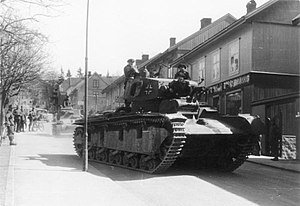Neubaufahrzeug
| Neubaufahrzeug | |
|---|---|

Neubaufahrzeug in Norway in April 1940
|
|
| Type | Tank |
| Place of origin | Nazi Germany |
| Service history | |
| In service | 1940 |
| Used by | Nazi Germany |
| Wars | World War II |
| Production history | |
| Designer | Rheinmetall |
| Designed | 1933–34 |
| Manufacturer | Rheinmetall |
| Produced | 1934–36 |
| No. built | 5 |
| Specifications | |
| Weight | 23.41 tonnes (23.04 long tons; 25.81 short tons) |
| Length | 6.6 m (21 ft 8 in) |
| Width | 2.19 m (7 ft 2 in) |
| Height | 2.98 m (9 ft 9 in) |
| Crew | 6 |
|
|
|
| Armor | 13–20 mm (0.51–0.79 in) |
|
Main
armament |
75 mm KwK L/24 or 105mm howitzer |
|
Secondary
armament |
37 mm KwK 36 (L/45) 2x 7.92 mm MG 13/34 |
| Engine | 290 hp BMW Va or 300 hp Maybach HL 108 TR |
| Suspension | coil springs |
|
Operational
range |
road: 120 kilometres (75 mi) |
| Speed | road: 25 km/h (16 mph) |
The German Neubaufahrzeug series of tank prototypes were a first attempt to create a heavy tank for the Wehrmacht after Adolf Hitler had come to power. Multi-turreted, heavy and slow, they were not considered successful, which led to only five being produced. These were primarily used for propaganda purposes, though three took part in the Battle of Norway in 1940.
During the 1920s and 1930s, a number of countries experimented with very large, multi-turreted tanks. The British built a single example of the Vickers A1E1 Independent in 1926. This inspired the Soviet T-35, which was built in limited numbers from 1933.
Development of the Neubaufahrzeug (German for "new construction vehicle" - a cover name) started in 1933 when the then Reichswehr gave a contract for the development of a Großtraktor ("heavy tractor") to both Rheinmetall and Krupp. Großtraktor was a codename for the development of a heavy tank, Germany being still forbidden to develop tanks under the terms of the Treaty of Versailles. The technical details of the Vickers A1E1 Independent were then available to the Germans as they were amongst the information sold to them by a British officer, Norman Baillie-Stewart, who acted as a German spy before his arrest in 1933.
The Rheinmetall and Krupp designs resembled each other to a great extent, the main difference being the weapons placement. Each had a main turret armed with a 75 mm KwK L/24 main gun and secondary 37 mm KwK L/45. Rheinmetall's design mounted the second gun above the 75 mm KwK L/24, while the Krupp design had it mounted next to the 75 mm KwK L/24. Both designs had a secondary turret mounted to the front and the rear of the main turret. These turrets were slightly adapted Panzer I turrets, with the standard machine gun armament.
Rheinmetall's design was designated PzKpfw NbFz V (PanzerKampfwagen NeubauFahrzeug V), and the Krupp design PzKpfw NbFz VI. It was intended that these designs would fulfill the role of heavy tank in the armored forces, but the design proved to be too complex and unreliable for this role. Nevertheless, development continued in order for the nascent German military to gain experience with multi-turreted tanks.
...
Wikipedia
